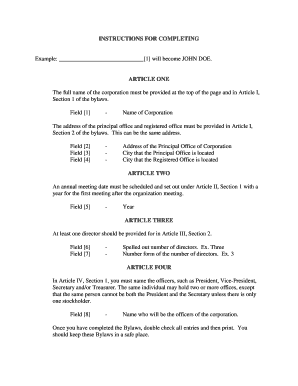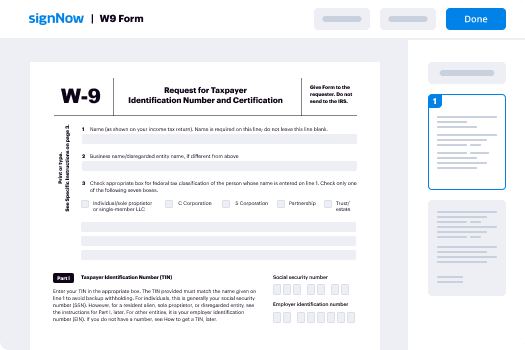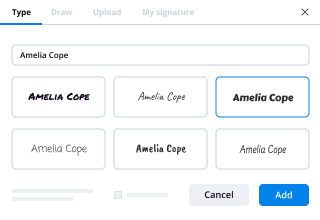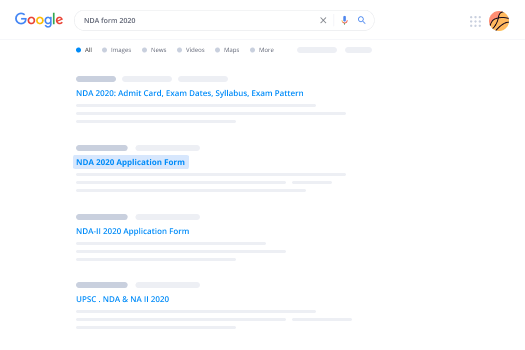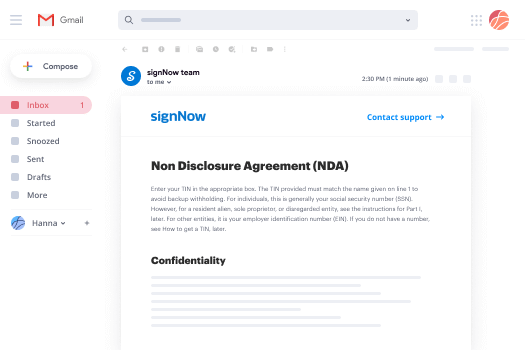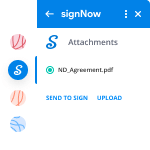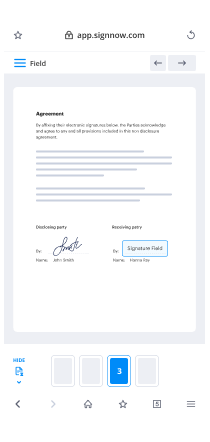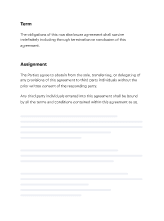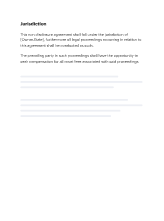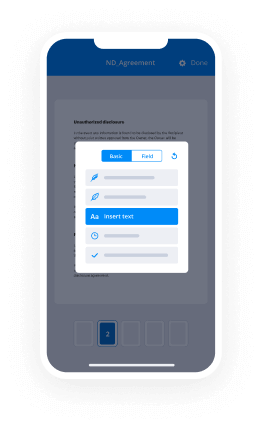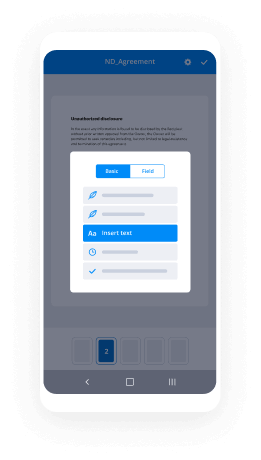INSTRUCTIONS FOR COMPLETING
Example: _____________________________[1] will become JOHN DOE.
AR TICLE ONE
The full name of the corporation must be provided at the top of the page and in Article I,
Section 1 of the bylaws.
Field [1] - Name of Corporation
The address of the principal office and registered office must be provided in Article I,
Secti on 2 of the bylaws. This can be the same address.
Field [2] - Address of the Principal Office of Corporation
Field [3] - City that the Principal Office is located
Field [4] - City that the Registered Office is located
ARTICLE TWO
An annual meeting date must be scheduled and set out under Article II, Section 1 with a
year for the first meeting after the organization meeting.
Field [5] - Year
ARTICLE THREE
At least one director should be provided for in Article III, Section 2.
Field [6] - Spelled out number of directors. Ex. Three
Field [7] - Number form of the number of directors. Ex. 3
ARTICLE FOUR
In Article IV, Section 1, you must name the officers , such as President, Vice -President,
Secretary and /or Treasurer. The same in dividual may hold two or more offices, except
that the same person cannot be both the President and the Secretary unless there is only
one stockholder.
Field [8] - Name who will be the officers of the corporation.
Once you have completed the Bylaws, double check all entries and then print. You
should keep these Bylaws in a safe place.
-1-
BY -LAWS
OF
______________________
ARTICLE I. NAME AND LOCATION
SECTION 1. The name of this corporation shall be ___________________________[1] .
SECTION 2. The Principal office of the cor poration in the State of Arkansas shall be
__________________________[2] , __ ________________________[3] , AR and its initial
registered office in the State of Arkansas shall be ___________[4] , Arkansas. The corporation
may have such other offices, either within or without the State of Arkansas as the Board of
Directors may designate or as the business of the corporation may require from time to time.
ARTICLE II. SHAREHOLDERS
SECTION 1. Annual Meeting . The annual meeting of the share holders shall be held on
the second Tuesday of the month of December in each year, beginning with the year
________________[5] at the time designated by the Board of Directors, for the purpose of
electing Directors and for the transaction of such other business as may come bef ore the meeting.
If the day fixed for the annual meeting shall be a legal holiday in the State of Arkansas, such
meeting shall be held on the next succeeding business day. If the election of Directors shall not
be held on the day designated herein for an y annual meeting of the shareholders, or at any
adjournment thereof, the Board of Directors shall cause the election to be held at a special
meeting of the shareholders as soon thereafter as convenient.
SECTION 2. Special Meeting . Special meetings of t he shareholders, for any purpose or
purposes, unless otherwise prescribed by statute, may be called by resolution of the Board of
Directors or by the President at the request of the holders of not less than a majority of all the
outstanding shares of the c orporation entitled to vote on any issue proposed to be considered at
the meeting, provided said shareholders sign, date and deliver to the corporate Secretary one or
more written demands for the meeting describing the purpose or purposes for which it is t o be
held. Only business within the purpose or purposes described in the meeting notice required by
Article II, Section 5 of these By -Laws may be conducted at a special shareholders meeting. In
addition, such meeting may be held at any time without call or notice upon unanimous consent of
shareholders.
SECTION 3. Place of Meeting . The Board of Directors may designate any place, either
within or without the State of Arkansas unless otherwise prescribed by statute as the place of
meeting for any annual meeting or for any special meeting of shareholders. A waiver of notice
signed by all shareholders entitled to vote at a meeting may designate any place, either within or
without the State of Arkansas, unless otherwise prescribed by statute, as the place f or the holding
-2-
of such meeting. If no designation is made, or if a special meeting be otherwise called, the place
of meeting shall be the principal office of the corporation in the State of Arkansas.
SECTION 4. Notice of Meeting . Written or printed no tice stating the place, day and
hour of the meeting shall be delivered not less than ten (10) nor more than sixty (60) days before
the date of the meeting, either personally or by mail, by or at the direction of the President, or the
Secretary, or the offi cer or persons calling the meeting, to each shareholder of record entitled to
vote at such meeting. If mailed, such notice shall be deemed to be delivered when deposited in
the United States mail, addressed to the shareholder at his address as it appears on the stock
transfer books of the corporation, with postage thereon prepaid. Notice of a special meeting
shall include a description of the purpose or purposes for which the meeting is called.
SECTION 5. Closing of Transfer Books or Fixing of Record D ate . For the purpose of
determining shareholders entitled to notice of or to vote at any meeting of shareholders or any
adjournment thereof, or shareholders entitled to receive payment of any dividend, or in order to
make a determination of share holders for any other proper purpose, the Board of Directors of the
corporation may provide that the stock transfer books shall be closed for a stated period but not
to exceed, in any case, seventy (70) days. If the stock transfer books shall be closed for the
pu rpose of determining shareholders entitled to notice of or to vote at a meeting of shareholders,
such books shall be closed for at least ten (10) days immediately preceding such meeting. In lieu
of closing the stock transfer books, the Board of Directors may fix in advance a date as the
record date for any determination of shareholders, such date in any case to be not more than
seventy (70) days and, in case of a meeting of share holders, not less than ten (10) days prior to
the date on which the particula r action, requiring such determination of share holders, is to be
taken. If the stock transfer books are not closed and no record date is fixed for the determination
of share holders entitled to notice of or to vote at a meeting of shareholders, or shareh olders
entitled to receive payment of a dividend, the date on which notice of the meeting is mailed or
the date on which resolution of the Board of Directors declaring such dividend is adopted, as the
case may be, shall be the record date for such determin ation of shareholders. When a
determination of shareholders entitled to vote at any meeting of shareholders has been made as
provided in this section, such determination shall apply to any adjournment thereof.
SECTION 6. Shareholders' List . After fixin g a record date, the officer or agent having
charge of the share ledger of the corporation shall prepare an alphabetical list of all persons
entitled to notice and to represent shares at such meeting, or any adjournment thereof, and said
list shall be arra nged by voting group and shall show the address of and the number of shares
held by each shareholder or representative. The shareholders' list shall be available for
inspection and copying during usual business hours by any shareholder beginning two (2)
business days after notice of the meeting is given for which the list was prepared and continuing
through the meeting, at the corporation's principal office or at a place identified in the meeting
notice. Such list shall be available during the meeting and any shareholder, his agent or attorney
is entitled to inspect the list at any time during the meeting or any adjournment thereof. The
original stock transfer book shall be prime facia evidence as to who are the shareholders entitled
to examine such list or transfer book or to vote at any meeting of shareholders.
-3-
SECTION 7. Quorum . A majority of the outstanding shares of the corporation entitled
to vote, represented in person or by proxy, shall constitute a quorum at a meeting of
shareholders. If le ss than a majority of the shares are represented at a meeting, a majority of the
shares so represented may adjourn the meeting from time to time without further notice. At such
adjourned meeting in which a quorum shall be present or represented, any busin ess may be
transacted which might have been transacted at the meeting as originally notified. The
shareholders present at a duly organized meeting may continue to transact business until
adjournment, notwithstanding the with drawal of enough shareholders to leave less than a
quorum.
SECTION 8. Proxies . At all meetings of shareholders, a shareholder may vote by proxy
executed in writing by the shareholder or by his duly authorized attorney -in-fact. Such proxy
shall be filed with the Secretary of the co rporation before or at the time of the meeting.
SECTION 9. Voting of Shares . Subject to the provisions of Section 12 of this Article II,
each outstanding share entitled to vote shall be entitled to one vote upon each matter submitted to
a vote at a mee ting of shareholders. The affirmative vote of a majority of the outstanding shares
represented at a shareholders' meeting at which a quorum is present shall be the act of the
shareholders of the corporation.
SECTION 10. Voting of Share by Certain Holde rs. Shares standing in the name of
another corporation may be voted by such officer, agent or proxy as the By -Laws of such
corporation may preserve, or, in the absence of such provision, as the Board of Directors of such
corporation may determine.
Share s held by an administrator, executor, guardian or con servatory may be voted by him
either in person or by proxy, with out a transfer of such shares into his name. Shares standing in
the name of a trustee may be voted by him, either in person or by proxy, but no trustee shall be
entitled to vote shares held by him without a transfer of such shares into his name.
Shares standing in the name of a receiver may be voted by such receiver, and shares held
by or under the control of a receiver may be voted by such receiver without the transfer there of
into his name if authority so to do be contained in appro priate order of the court by which such
receiver was appointed.
A shareholder whose shares are pledged shall be entitled to vote such shares until th e
shares have been transferred into the name of the pledgee, and thereafter the pledgee shall be
entitled to vote the shares so transferred.
Shares of its own stock belonging to the corporation or held by it in a fiduciary capacity
shall not be voted, di rectly or indirectly, at any meeting, and shall not be counted in determining
the total number of outstanding shares at any given time.
SECTION 11. Informal Action by Shareholders . Unless otherwise provided by law, any
action required to be taken at a meeting of the shareholders, or any other action which may be
taken at a meeting of the shareholders, may be taken without a meeting if a consent in writing,
-4-
setting forth the action so taken, shall be signed by all of the shareholders entitled to vote wit h
respect to the subject matter thereof.
SECTION 12. Cumulative Voting . Unless otherwise provided by law, at each election
for Directors every shareholder entitled to vote, in person or by proxy, shall have the right to
vote at such election the number of shares owned by him for as many persons as there are
Directors to be elected and for whose election he has a right to vote, or to cumulate his votes by
giving one candidate as many votes as the number of such Directors multiplied by the number of
his s hares shall equal, or by distributing such votes on the same principle among any number of
candidates.
ARTICLE III. BOARD OF DIRECTORS
SECTION 1. General Powers . The business and affairs of the corporation shall be
managed by its Board of Directors e xcept as otherwise herein provided.
SECTION 2. Number, Tenure and Qualifications . The number of Directors of the
corporation shall be _______________[6] (________[7] ). Each Director shall hold office until
the next annual meeting of shareholders and until his successor shall have been elected and
qualified. Directors may be re -elected. The Directors need not be a resident of this state or a
shareholder.
SE CTION 3. Regular Meetings . A regular meeting of the Board of Directors shall be
held without other notice than this By -Law immediately after, and at the same place as the
annual meeting of shareholders. The Board of Directors may also provide, by resolu tion, the
time and place for the holding of additional regular meetings without other notice than such
resolution.
SECTION 4. Special Meetings . Special meetings of the Board of Directors may be
called by or at the request of the President or any Direct or. The person or persons authorized to
call special meetings of the Board of Directors may fix the place for holding any special meeting
of the Board of Directors called by them.
SECTION 5. Notice . Notice of any special meeting shall be given at le ast five (5) days
previously thereto by notice personally given or mailed to each Director at his business address,
or by telegram. If mailed, such notice shall be deemed to be delivered when deposited in the
United States mail so addressed, with postage thereon prepaid. If notice be given by telegram,
such notice shall be deemed to be delivered when the telegram is delivered to the telegraph
company. Any Director may waive notice of any meeting. The attendance of a Director at a
meeting shall constitut e a waiver of notice of such meeting, except where a Director attends a
meeting for the express purpose of objecting to the transaction of any business because the
meeting is not lawfully called or convened, and does not thereafter vote for or assent to ac tion
taken at the meeting.
SECTION 6. Quorum . A majority of the number of Directors fixed by Section 2 of this
Article III shall constitute a quorum for the transaction of business at any meeting of the Board
-5-
of Directors, but if less than a majority i s present at a meeting, a majority of the Directors present
may adjourn the meeting from time to time without further notice.
SECTION 7. Manner of Acting . The act of the majority of the Directors present at a
meeting at which a quorum is present shall be the act or the Board of Directors.
SECTION 8. Compensation . By resolution of the Board of Directors, the Directors may
be paid their expenses, if any, of at tendance at each meeting of the Board of Directors and may
be paid a fixed sum for attendance at each meeting of the Board of Directors or a stated salary as
Director. No such payment shall preclude any Director from serving the corporation in any other
capacity and receiving compensation therefore.
SECTION 9. Presumption of Assent . A Director of the corporation who is present at a
meeting of the Board of Directors at which action on any corporate matter is taken shall be
presumed to have assented to th e action taken unless his dissent shall be entered in the minutes
of the meeting or unless he shall file his written dissent to such action with the person acting as
Secretary of the meeting before the adjournment thereof or shall forward such dissent by
registered mail to the Secretary of the corporation immediately after the adjournment of the
meeting. Such right to dissent shall not apply to a Director who voted in favor of such action.
SECTION 10. Informal Action by Board of Directors . Unless other wise provided by
law, any action required to be taken at a meeting of the Directors, or any other action which may
be taken at a meeting of the Directors, may be taken without a meeting if a consent in writing,
setting forth the action so taken, shall be s igned by each director, and included in the minutes or
filed with the corporate records reflecting the action taken.
ARTICLE IV. OFFICERS
SECTION 1. Number . The officers of the corporation shall be a _________________[8]
[President, one or more Vice -Presidents and a Secretary], each of whom shall be elected by the
Board of Directors. Such other officers and assistant officers as may be deemed necessary may
be elected or appointed by the Board of Directors.
SECTION 2. Election and Term of Office . The officers of the corporation to be elected
by the Board o f Directors shall be elected annually by the Board of Directors at the first meeting
of the Board of Directors held after each annual meeting of the shareholders. If the election of
officers shall not be held at such meeting, such election shall be held a s soon thereafter as
conveniently may be. Each officer shall hold office until his successor shall have been duly
elected and shall have qualified or until he shall resign or shall have been removed in the manner
hereinafter provided. The initial officer s may be elected at the first meeting of the Board of
Directors.
SECTION 3. Removal . Any officer or agent elected or appointed by the Board of
Directors may be removed by the Board of Directors whenever in its judgment, the best interest
of the corpora tion would be served thereby, but such removal shall be without prejudice to the
contract rights, if any, of the person so removed.
-6-
SECTION 4. Vacancies . A vacancy in any office because of death, resignation,
removal, disqualification or otherwise, m ay be filed by the Board of Directors for the unexpired
portion of the term.
SECTION 5. President . The President shall be the principal executive officer of the
corporation and, subject to the control of the Board of Directors, shall in general supervi se and
control all of the business and affairs of the corporation. He shall, when present, preside at all
meetings of the shareholders and of the Board of Directors. He may sign certificates for shares
of the corporation, any deeds, mortgages, bonds, con tracts, or other instruments which the Board
of Directors has authorized to be executed except in cases where the signing and execution
thereof shall be expressly delegated by the Board of Directors, or by these By -Laws, to some
other officer or agent of t he corporation, or shall be required by law to be otherwise signed or
executed; and in general shall perform all duties incident to the office of President and such other
duties as may be prescribed by the Board of Directors from time to time.
SECTION 6. Vice -President . The Board of Directors may determine when there is a
need for a Vice -President or Vice - Presidents. In the absence of the President or in event of his
death, unavailability of or refusal to act, a Vice -President shall perform the duties of the
President, and when so acting, shall have all the powers of and be subject to all the restrictions
upon the President. A Vice -President shall perform such other duties as from time to time may
be assigned to him by the President or the Board of Di rectors.
SECTION 7. Secretary . The Secretary shall: (a) keep the minutes of the shareholders
and of the Board of Directors meetings in one or more books provided for the purpose; (b) be
custodian of the corporate records and of the seal of the corporation and see that the seal of the
corporation is affixed to all documents, the execution of which on behalf of the corporation
under its seal is duly authorized; (c) see that all notices are duly given in accordance with the
provisions of these By -Laws or as required by law; (d) keep a register of the post office address
of each shareholder which shall be furnished to the Secretar y by such shareholder; (e) have
general charge of the stock transfer books of the corporation; (f) have charge and custody of and
be responsible for all funds and securities of the corporation, receive and give receipts for monies
due and payable to the co rporation from any source whatsoever, and deposit all such monies in
the name of the corporation in such banks, trust companies or other depositories as shall be
selected in accordance with the provisions of Article V of these By -Laws; and (g) in general
perform all of the duties incident to the Office of Secretary and such other duties as from time to
time may be assigned to him by the President or by the Board of Directors. If required by the
Board of Directors, the Secretary shall give a bond for the fa ithful discharge of his duties in such
sum with such surety or sureties as the Board of Directors shall determine.
SECTION 8. Salaries . The salaries, compensation and other benefits, if any, of the
officers shall be fixed from time to time by the Board of Directors, and no officer shall be
prevented from receiving such salary by reason of the fact that he is also a Director of the
corporation.
-7-
ARTICLE V. CONTRACTS, LOANS, CHECKS AND DEPOSITS
SECTION 1. Contracts . The Board of Directors may author ize any officer or officers,
agent or agents, to enter into any contract or execute and deliver any instrument in the name of
and on behalf of the corporation, and such authority may be general or confined to specific
instances.
SECTION 2. Loans . No lo ans shall be contracted on behalf of the corporation and no
evidence of indebtedness shall be issued in its name unless authorized by a resolution of the
Board of Directors. Such authority may be general or confined to specific instances.
SECTION 3. Ch ecks, Drafts, etc . All checks, drafts, or other orders for the payment of
money, notes or other evidences of indebtedness issued in the name of the corporation shall be
signed by such officer or officers, agent or agents of the cor poration and in such ma nner as shall
from time to time be determined by resolution of the Board of Directors.
SECTION 4. Deposits . All funds of the corporation not otherwise employed shall be
deposited from time to time to the credit of the corporation in such banks, trust c ompanies or
other depositories as the Board of Directors may select.
ARTICLE VI. CERTIFICATES FOR SHARES AND THEIR TRANSFER
SECTION 1. Certificates for Shares . Certificates repre senting shares of the corporation
shall be in such form as shall be det ermined by the Board of Directors. Such certificates shall be
signed by the President and by the Secretary or by such other officers authorized by law and by
the Board of Directors so to do. All certificates for shares shall be consecutively numbered or
otherwise identified. The name and address of the person to whom the shares represented
thereby are issued, with the number of shares and date of issuance, shall be entered on the stock
transfer books of the corporation. All certificates surrendered to t he corporation for transfer shall
be canceled and no new certificate shall be issued until the former certificate for a like number of
shares shall have been surrendered and canceled, except that in case of a lost, destroyed or
mutilated certificate, a new one may be issued therefore upon such terms and indemnity to the
corporation as the Board of Directors may pre scribe.
SECTION 2. Transfer of Shares . Transfer of shares of the corporation shall be made
only on the stock transfer books of the corpora tion by the holder of record thereof or by his legal
representative, who shall furnish proper evidence of authority to transfer, or by his attorney
thereunto authorized by power of attorney duly executed and filed with the Secretary of the
corporation, and on surrender for cancellation of the certificate of such shares, and also, any
transfer is subject to the limitations set forth in the Articles of Incorporation, reference to which
is hereby made. The person in whose name shares stand on the books of the corporation shall be
deemed by the corporation to be the owner thereof for all purposes.
-8-
ARTICLE VII. FISCAL YEAR
The fiscal year of the corporation shall begin on the 1st day of January and end on the
31st day of December in each year.
ARTICLE VIII. DIVIDENDS
The Board of Directors may from time to time declare, and the corporation may pay
dividends on its outstanding shares in the manner and upon the terms and conditions provided by
law and its Articles of Incorporation.
ARTICLE IX. SEAL
The Board of Directors shall provide a corporate seal which shall be circular in form and
shall have inscribed thereon the name of the corporation and the state of incorporation and the
words "Corporate Seal."
ARTICLE X. WAIVER OF NOTICE
Unles s otherwise provided by law, whenever any notice is required to be given to any
shareholder or Director of the corporation under the provisions of these By -Laws or under the
provisions of the Articles of Incorporation, a waiver thereof in writing, signed b y the person or
persons entitled to such notice, whether before or after the time stated therein, shall be equiva lent
to the giving of such notice.
ARTICLE XI. AMENDMENTS
These By -Laws may be altered, amended or repealed and new By -Laws may be adopted
by a majority vote of the Board of Directors at any annual Board of Directors meeting or at any
special Board of Directors meeting when the proposed amendment has been set out in the notice
of such meeting. These By -Laws may also be altered, amended or r epealed by a majority vote of
the shareholders notwithstanding that these By -Laws may also be amended or repealed by the
Board of Directors.
